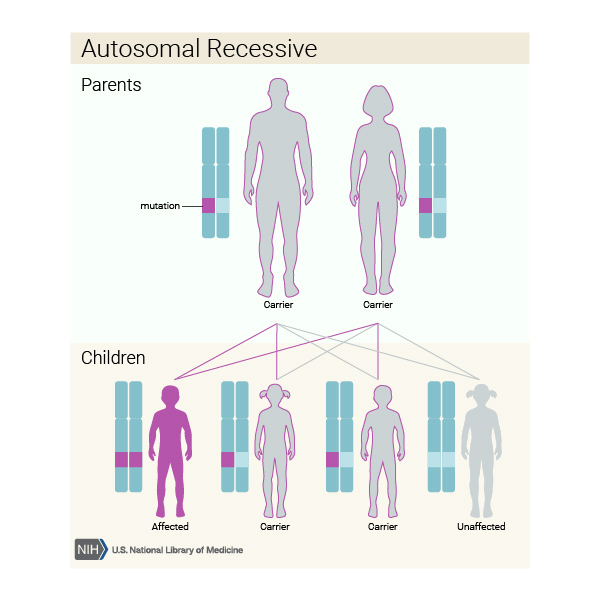What is a recessive disorder?
A recessive disorder is one that has a specific disease mechanism. For a recessive disorder to occur, both copies of the causative gene must be mutated for a patient to show symptoms. Ataxias that follow this disease mechanism are known as recessive ataxia. However, having a mutation in only one copy of the gene does not lead to a disorder. As people with only one mutated copy of the gene can pass on the defective gene, these people are known as an unaffected carrier. Recessive ataxias range in symptoms and severity but are linked by their disease mechanism. While none of the Spinocerebellar Ataxias (SCAs) are recessive, there are many types of recessive ataxias, including Autosomal Recessive Cerebellar Ataxia Type 1 and 2 (ARCA1 and ARCA2), Autosomal Recessive Spastic Ataxia of Charlevoix-Saguenay (ARSACS), Friedreich’s Ataxia, and Ataxia Telangiectasia. For example, Friedreich’s Ataxia is caused by a trinucleotide repeat expansion in the frataxin (FXN) gene. People with only one expanded copy of the FXN gene do not show any symptoms, while people with two expanded copies of the FXN gene are affected by Friedreich’s Ataxia.

How are recessive ataxias inherited?
For every gene in our body, we have two copies, one that is inherited from our mother and one from our father. Both parents of an affected individual have to have at least one copy of the mutation for a child to be born with a recessive disorder. If both parents are unaffected carriers, each child will have a 1 in 4 chance of getting the disorder.
For a patient affected with a recessive ataxia, the chances of having a child affected by the same disorder are low. For a patient to pass on the disease, their spouse must have at least one mutated copy of the causative gene. In the case where a patient’s spouse is a carrier, children have an equal chance of being an unaffected carrier or being affected by the disease. However, carrier rates for ataxias are low in the population, which makes it unlikely that a patient’s spouse is also a carrier for the ataxia mutation.
How can a patient prevent passing on a recessive disorder to their children?
Generally, when a patient with recessive ataxia passes on the disorder to their children, their spouse is an unaffected carrier. If you are a patient with a form of recessive ataxia and are thinking about having children, your spouse can undergo carrier testing to find out if they are a carrier for the same recessive ataxia. This will determine the likelihood that the recessive ataxia is passed on to your children. If it is determined that the spouse is a carrier, options like IVF with embryo screening can help patients prevent passing on recessive ataxia to their children.
If you would like to know more trinucleotide repeat expansions, you can look at our past Snapshot on Polyglutamine Expansion.
If you would like to learn more about carrier and embryo screening, take a look at these resources by the American College of Obstetricians & Gynecologists and Integrated Genetics.
Snapshot written by Eder Xhako and edited by Larissa Nitschke.










